6.4: Acondicionamiento Operante
- Page ID
- 143275
\( \newcommand{\vecs}[1]{\overset { \scriptstyle \rightharpoonup} {\mathbf{#1}} } \)
\( \newcommand{\vecd}[1]{\overset{-\!-\!\rightharpoonup}{\vphantom{a}\smash {#1}}} \)
\( \newcommand{\dsum}{\displaystyle\sum\limits} \)
\( \newcommand{\dint}{\displaystyle\int\limits} \)
\( \newcommand{\dlim}{\displaystyle\lim\limits} \)
\( \newcommand{\id}{\mathrm{id}}\) \( \newcommand{\Span}{\mathrm{span}}\)
( \newcommand{\kernel}{\mathrm{null}\,}\) \( \newcommand{\range}{\mathrm{range}\,}\)
\( \newcommand{\RealPart}{\mathrm{Re}}\) \( \newcommand{\ImaginaryPart}{\mathrm{Im}}\)
\( \newcommand{\Argument}{\mathrm{Arg}}\) \( \newcommand{\norm}[1]{\| #1 \|}\)
\( \newcommand{\inner}[2]{\langle #1, #2 \rangle}\)
\( \newcommand{\Span}{\mathrm{span}}\)
\( \newcommand{\id}{\mathrm{id}}\)
\( \newcommand{\Span}{\mathrm{span}}\)
\( \newcommand{\kernel}{\mathrm{null}\,}\)
\( \newcommand{\range}{\mathrm{range}\,}\)
\( \newcommand{\RealPart}{\mathrm{Re}}\)
\( \newcommand{\ImaginaryPart}{\mathrm{Im}}\)
\( \newcommand{\Argument}{\mathrm{Arg}}\)
\( \newcommand{\norm}[1]{\| #1 \|}\)
\( \newcommand{\inner}[2]{\langle #1, #2 \rangle}\)
\( \newcommand{\Span}{\mathrm{span}}\) \( \newcommand{\AA}{\unicode[.8,0]{x212B}}\)
\( \newcommand{\vectorA}[1]{\vec{#1}} % arrow\)
\( \newcommand{\vectorAt}[1]{\vec{\text{#1}}} % arrow\)
\( \newcommand{\vectorB}[1]{\overset { \scriptstyle \rightharpoonup} {\mathbf{#1}} } \)
\( \newcommand{\vectorC}[1]{\textbf{#1}} \)
\( \newcommand{\vectorD}[1]{\overrightarrow{#1}} \)
\( \newcommand{\vectorDt}[1]{\overrightarrow{\text{#1}}} \)
\( \newcommand{\vectE}[1]{\overset{-\!-\!\rightharpoonup}{\vphantom{a}\smash{\mathbf {#1}}}} \)
\( \newcommand{\vecs}[1]{\overset { \scriptstyle \rightharpoonup} {\mathbf{#1}} } \)
\( \newcommand{\vecd}[1]{\overset{-\!-\!\rightharpoonup}{\vphantom{a}\smash {#1}}} \)
\(\newcommand{\avec}{\mathbf a}\) \(\newcommand{\bvec}{\mathbf b}\) \(\newcommand{\cvec}{\mathbf c}\) \(\newcommand{\dvec}{\mathbf d}\) \(\newcommand{\dtil}{\widetilde{\mathbf d}}\) \(\newcommand{\evec}{\mathbf e}\) \(\newcommand{\fvec}{\mathbf f}\) \(\newcommand{\nvec}{\mathbf n}\) \(\newcommand{\pvec}{\mathbf p}\) \(\newcommand{\qvec}{\mathbf q}\) \(\newcommand{\svec}{\mathbf s}\) \(\newcommand{\tvec}{\mathbf t}\) \(\newcommand{\uvec}{\mathbf u}\) \(\newcommand{\vvec}{\mathbf v}\) \(\newcommand{\wvec}{\mathbf w}\) \(\newcommand{\xvec}{\mathbf x}\) \(\newcommand{\yvec}{\mathbf y}\) \(\newcommand{\zvec}{\mathbf z}\) \(\newcommand{\rvec}{\mathbf r}\) \(\newcommand{\mvec}{\mathbf m}\) \(\newcommand{\zerovec}{\mathbf 0}\) \(\newcommand{\onevec}{\mathbf 1}\) \(\newcommand{\real}{\mathbb R}\) \(\newcommand{\twovec}[2]{\left[\begin{array}{r}#1 \\ #2 \end{array}\right]}\) \(\newcommand{\ctwovec}[2]{\left[\begin{array}{c}#1 \\ #2 \end{array}\right]}\) \(\newcommand{\threevec}[3]{\left[\begin{array}{r}#1 \\ #2 \\ #3 \end{array}\right]}\) \(\newcommand{\cthreevec}[3]{\left[\begin{array}{c}#1 \\ #2 \\ #3 \end{array}\right]}\) \(\newcommand{\fourvec}[4]{\left[\begin{array}{r}#1 \\ #2 \\ #3 \\ #4 \end{array}\right]}\) \(\newcommand{\cfourvec}[4]{\left[\begin{array}{c}#1 \\ #2 \\ #3 \\ #4 \end{array}\right]}\) \(\newcommand{\fivevec}[5]{\left[\begin{array}{r}#1 \\ #2 \\ #3 \\ #4 \\ #5 \\ \end{array}\right]}\) \(\newcommand{\cfivevec}[5]{\left[\begin{array}{c}#1 \\ #2 \\ #3 \\ #4 \\ #5 \\ \end{array}\right]}\) \(\newcommand{\mattwo}[4]{\left[\begin{array}{rr}#1 \amp #2 \\ #3 \amp #4 \\ \end{array}\right]}\) \(\newcommand{\laspan}[1]{\text{Span}\{#1\}}\) \(\newcommand{\bcal}{\cal B}\) \(\newcommand{\ccal}{\cal C}\) \(\newcommand{\scal}{\cal S}\) \(\newcommand{\wcal}{\cal W}\) \(\newcommand{\ecal}{\cal E}\) \(\newcommand{\coords}[2]{\left\{#1\right\}_{#2}}\) \(\newcommand{\gray}[1]{\color{gray}{#1}}\) \(\newcommand{\lgray}[1]{\color{lightgray}{#1}}\) \(\newcommand{\rank}{\operatorname{rank}}\) \(\newcommand{\row}{\text{Row}}\) \(\newcommand{\col}{\text{Col}}\) \(\renewcommand{\row}{\text{Row}}\) \(\newcommand{\nul}{\text{Nul}}\) \(\newcommand{\var}{\text{Var}}\) \(\newcommand{\corr}{\text{corr}}\) \(\newcommand{\len}[1]{\left|#1\right|}\) \(\newcommand{\bbar}{\overline{\bvec}}\) \(\newcommand{\bhat}{\widehat{\bvec}}\) \(\newcommand{\bperp}{\bvec^\perp}\) \(\newcommand{\xhat}{\widehat{\xvec}}\) \(\newcommand{\vhat}{\widehat{\vvec}}\) \(\newcommand{\uhat}{\widehat{\uvec}}\) \(\newcommand{\what}{\widehat{\wvec}}\) \(\newcommand{\Sighat}{\widehat{\Sigma}}\) \(\newcommand{\lt}{<}\) \(\newcommand{\gt}{>}\) \(\newcommand{\amp}{&}\) \(\definecolor{fillinmathshade}{gray}{0.9}\)Objetivos de aprendizaje
- Definir condicionamiento operante
- Explicar la diferencia entre el refuerzo y el castigo
- Distinguir entre programas de refuerzo
La sección anterior de este capítulo se centró en el tipo de aprendizaje asociativo conocido como condicionamiento clásico. Recuerda que en el condicionamiento clásico, algo en el ambiente desencadena un reflejo automáticamente, y los investigadores entrenan al organismo para que reaccione ante un estímulo diferente. Ahora pasamos al segundo tipo de aprendizaje asociativo, el condicionamiento operante. En el condicionamiento operante, los organismos aprenden a asociar un comportamiento y su consecuencia (Ver tabla a continuación). Una consecuencia agradable hace que ese comportamiento sea más probable que se repita en el futuro. Por ejemplo, Spirit, un delfín en el Acuario Nacional de Baltimore, da una vuelta al aire cuando su entrenador hace sonar un silbato. La consecuencia es que ella consigue un pez.
| Acondicionamiento Clásico | Acondicionamiento Operante | |
|---|---|---|
| Enfoque de acondicionamiento | Un estímulo incondicionado (como la comida) se combina con un estímulo neutro (como una campana). El estímulo neutro finalmente se convierte en el estímulo condicionado, lo que provoca la respuesta condicionada (salivación). | El comportamiento objetivo es seguido de refuerzo o castigo para fortalecerlo o debilitarlo, de manera que el alumno tenga más probabilidades de exhibir el comportamiento deseado en el futuro. |
| Momento de estímulo | El estímulo ocurre inmediatamente antes de la respuesta. | El estímulo (ya sea refuerzo o castigo) ocurre poco después de la respuesta. |
El psicólogo B. F. Skinner vio que el condicionamiento clásico se limita a comportamientos existentes que se provocan reflexivamente, y no da cuenta de nuevos comportamientos como andar en bicicleta. Propuso una teoría sobre cómo se producen tales comportamientos. Skinner creía que el comportamiento está motivado por las consecuencias que recibimos por el comportamiento: los refuerzos y castigos. Su idea de que el aprendizaje es resultado de consecuencias se basa en la ley de efecto, la cual fue propuesta por primera vez por el psicólogo Edward Thorndike. De acuerdo con la ley del efecto, los comportamientos que van seguidos de consecuencias que son satisfactorias para el organismo tienen más probabilidades de repetirse, y los comportamientos que van seguidos de consecuencias desagradables tienen menos probabilidades de repetirse (Thorndike, 1911). Esencialmente, si un organismo hace algo que produce un resultado deseado, es más probable que el organismo vuelva a hacerlo. Si un organismo hace algo que no produce un resultado deseado, es menos probable que el organismo vuelva a hacerlo. Un ejemplo de la ley de efectos es en el empleo. Una de las razones (y muchas veces la razón principal) por las que nos presentamos al trabajo es porque nos pagan por hacerlo. Si dejamos de recibir pagos, es probable que dejemos de presentarnos, incluso si amamos nuestro trabajo.
Trabajando con la ley de efecto de Thorndike como su fundamento, Skinner comenzó a realizar experimentos científicos en animales (principalmente ratas y palomas) para determinar cómo los organismos aprenden a través del condicionamiento operante (Skinner, 1938). Colocó a estos animales dentro de una cámara de acondicionamiento operante, la cual ha llegado a conocerse como una “caja Skinner”. Una caja de Skinner contiene una palanca (para ratas) o disco (para palomas) que el animal puede presionar o picotear para obtener una recompensa de comida a través del dispensador. Altavoces y luces pueden estar asociados con ciertos comportamientos. Un registrador cuenta el número de respuestas realizadas por el animal.
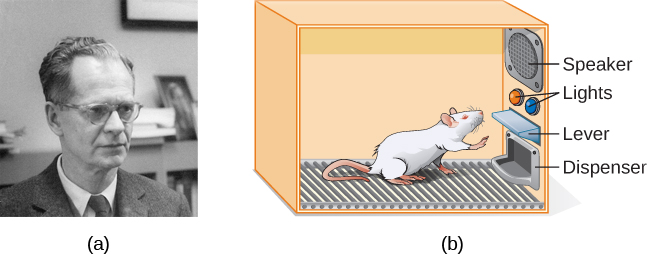
Al discutir el condicionamiento operante, usamos varias palabras cotidianas —positivas, negativas, refuerzo y castigo— de manera especializada. En condicionamiento operante, positivo y negativo no significan bueno y malo. En cambio, positivo significa que estás agregando algo, y negativo significa que te estás quitando algo. Refuerzo significa que estás aumentando un comportamiento, y el castigo significa que estás disminuyendo un comportamiento. El refuerzo puede ser positivo o negativo, y el castigo también puede ser positivo o negativo. Todos los refuerzos (positivos o negativos) aumentan la probabilidad de una respuesta conductual. Todos los castigos (positivos o negativos) disminuyen la probabilidad de una respuesta conductual. Ahora combinemos estos cuatro términos: refuerzo positivo, refuerzo negativo, castigo positivo y castigo negativo. (Ver tabla a continuación.)
| Refuerzo | Castigo | |
|---|---|---|
| Positivo | Se agrega algo para aumentar la probabilidad de un comportamiento. | Se agrega algo para disminuir la probabilidad de un comportamiento. |
| Negativo | Algo se elimina para aumentar la probabilidad de un comportamiento. | Algo se elimina para disminuir la probabilidad de un comportamiento. |
Refuerzo
La forma más efectiva de enseñar a una persona o animal un nuevo comportamiento es con un refuerzo positivo. En refuerzo positivo, se agrega un estímulo deseable para incrementar un comportamiento.
Por ejemplo, le dices a tu hijo de cinco años, Jerome, que si limpia su habitación, obtendrá un juguete. Jerome limpia rápidamente su habitación porque quiere un nuevo set de arte. Hagamos una pausa por un momento. Algunas personas podrían decir: “¿Por qué debería recompensar a mi hijo por hacer lo que se espera?” Pero de hecho somos constantemente y consistentemente recompensados en nuestras vidas. Nuestros cheques de pago son recompensas, así como las calificaciones altas y la aceptación en nuestra escuela preferida. Ser elogiado por hacer un buen trabajo y por aprobar una prueba de manejo también es una recompensa. El refuerzo positivo como herramienta de aprendizaje es extremadamente efectivo. Se ha encontrado que una de las formas más efectivas de aumentar el rendimiento en distritos escolares con puntajes de lectura por debajo del promedio fue pagar a los niños para que lean. Específicamente, a los estudiantes de segundo grado en Dallas se les pagaba\(\$2\) cada vez que leían un libro y pasaban un breve cuestionario sobre el libro. El resultado fue un incremento significativo en la comprensión lectora (Fryer, 2010). ¿Qué opinas de este programa? Si Skinner estuviera vivo hoy, probablemente pensaría que esta fue una gran idea. Fue un firme proponente del uso de principios de condicionamiento operante para influir en el comportamiento de los estudiantes en la escuela. De hecho, además de la caja de Skinner, también inventó lo que llamó una máquina de enseñanza que fue diseñada para recompensar pequeños pasos en el aprendizaje (Skinner, 1961) —un precursor temprano del aprendizaje asistido por computadora. Su máquina de enseñanza probó los conocimientos de los estudiantes mientras trabajaban en diversas materias escolares. Si los alumnos respondían correctamente las preguntas, recibían un refuerzo positivo inmediato y podían continuar; si respondían incorrectamente, no recibían ningún refuerzo. La idea era que los estudiantes dedicaran más tiempo a estudiar el material para aumentar sus posibilidades de ser reforzados la próxima vez (Skinner, 1961).
En el refuerzo negativo, se elimina un estímulo indeseable para aumentar un comportamiento. Por ejemplo, los fabricantes de automóviles utilizan los principios de refuerzo negativo en sus sistemas de cinturones de seguridad, que van “pitido, pitido, pitido” hasta que se abrocha el cinturón de seguridad. El molesto sonido se detiene cuando exhibas el comportamiento deseado, aumentando la probabilidad de que te abroches el cinturón en el futuro. El refuerzo negativo también se usa frecuentemente en el entrenamiento de caballos. Los jinetes aplican presión, tirando de las riendas o apretando sus piernas, y luego eliminan la presión cuando el caballo realiza el comportamiento deseado, como girar o acelerar. La presión es el estímulo negativo que el caballo quiere eliminar.
Punishment
Many people confuse negative reinforcement with punishment in operant conditioning, but they are two very different mechanisms. Remember that reinforcement, even when it is negative, always increases a behavior. In contrast, punishment always decreases a behavior. In positive punishment, you add an undesirable stimulus to decrease a behavior. An example of positive punishment is scolding a student to get the student to stop texting in class. In this case, a stimulus (the reprimand) is added in order to decrease the behavior (texting in class). In negative punishment, you remove an aversive stimulus to decrease behavior. For example, when a child misbehaves, a parent can take away a favorite toy. In this case, a stimulus (the toy) is removed in order to decrease the behavior.
Punishment, especially when it is immediate, is one way to decrease undesirable behavior. For example, imagine your four-year-old son, Brandon, hit his younger brother. You have Brandon write \(100\) times “I will not hit my brother" (positive punishment). Chances are he won’t repeat this behavior. While strategies like this are common today, in the past children were often subject to physical punishment, such as spanking. It’s important to be aware of some of the drawbacks in using physical punishment on children. First, punishment may teach fear. Brandon may become fearful of the street, but he also may become fearful of the person who delivered the punishment—you, his parent. Similarly, children who are punished by teachers may come to fear the teacher and try to avoid school (Gershoff et al., 2010). Consequently, most schools in the United States have banned corporal punishment. Second, punishment may cause children to become more aggressive and prone to antisocial behavior and delinquency (Gershoff, 2002). They see their parents resort to spanking when they become angry and frustrated, so, in turn, they may act out this same behavior when they become angry and frustrated. For example, because you spank Brenda when you are angry with her for her misbehavior, she might start hitting her friends when they won’t share their toys.
While positive punishment can be effective in some cases, Skinner suggested that the use of punishment should be weighed against the possible negative effects. Today’s psychologists and parenting experts favor reinforcement over punishment—they recommend that you catch your child doing something good and reward her for it.
Shaping
In his operant conditioning experiments, Skinner often used an approach called shaping. Instead of rewarding only the target behavior, in shaping, we reward successive approximations of a target behavior. Why is shaping needed? Remember that in order for reinforcement to work, the organism must first display the behavior. Shaping is needed because it is extremely unlikely that an organism will display anything but the simplest of behaviors spontaneously. In shaping, behaviors are broken down into many small, achievable steps. The specific steps used in the process are the following:
- Reinforce any response that resembles the desired behavior.
- Then reinforce the response that more closely resembles the desired behavior. You will no longer reinforce the previously reinforced response.
- Next, begin to reinforce the response that even more closely resembles the desired behavior.
- Continue to reinforce closer and closer approximations of the desired behavior.
- Finally, only reinforce the desired behavior.
Shaping is often used in teaching a complex behavior or chain of behaviors. Skinner used shaping to teach pigeons not only such relatively simple behaviors as pecking a disk in a Skinner box, but also many unusual and entertaining behaviors, such as turning in circles, walking in figure eights, and even playing ping pong; the technique is commonly used by animal trainers today. An important part of shaping is stimulus discrimination. Recall Pavlov’s dogs—he trained them to respond to the tone of a bell, and not to similar tones or sounds. This discrimination is also important in operant conditioning and in shaping behavior.
It’s easy to see how shaping is effective in teaching behaviors to animals, but how does shaping work with humans? Let’s consider parents whose goal is to have their child learn to clean his room. They use shaping to help him master steps toward the goal. Instead of performing the entire task, they set up these steps and reinforce each step. First, he cleans up one toy. Second, he cleans up five toys. Third, he chooses whether to pick up ten toys or put his books and clothes away. Fourth, he cleans up everything except two toys. Finally, he cleans his entire room.
Primary and Secondary Reinforcers
Rewards such as stickers, praise, money, toys, and more can be used to reinforce learning. Let’s go back to Skinner’s rats again. How did the rats learn to press the lever in the Skinner box? They were rewarded with food each time they pressed the lever. For animals, food would be an obvious reinforcer.
What would be a good reinforce for humans? For your daughter Sydney, it was the promise of a toy if she cleaned her room. How about Joaquin, the soccer player? If you gave Joaquin a piece of candy every time he made a goal, you would be using a primary reinforcer. Primary reinforcers are reinforcers that have innate reinforcing qualities. These kinds of reinforcers are not learned. Water, food, sleep, shelter, sex, and touch, among others, are primary reinforcers. Pleasure is also a primary reinforcer. Organisms do not lose their drive for these things. For most people, jumping in a cool lake on a very hot day would be reinforcing and the cool lake would be innately reinforcing—the water would cool the person off (a physical need), as well as provide pleasure.
A secondary reinforcer has no inherent value and only has reinforcing qualities when linked with a primary reinforcer. Praise, linked to affection, is one example of a secondary reinforcer, as when you called out “Great shot!” every time Joaquin made a goal. Another example, money, is only worth something when you can use it to buy other things—either things that satisfy basic needs (food, water, shelter—all primary reinforcers) or other secondary reinforcers. If you were on a remote island in the middle of the Pacific Ocean and you had stacks of money, the money would not be useful if you could not spend it. What about the stickers on the behavior chart? They also are secondary reinforcers.
Sometimes, instead of stickers on a sticker chart, a token is used. Tokens, which are also secondary reinforcers, can then be traded in for rewards and prizes. Entire behavior management systems, known as token economies, are built around the use of these kinds of token reinforcers. Token economies have been found to be very effective at modifying behavior in a variety of settings such as schools, prisons, and mental hospitals. For example, a study by Cangi and Daly (2013) found that use of a token economy increased appropriate social behaviors and reduced inappropriate behaviors in a group of autistic school children. Autistic children tend to exhibit disruptive behaviors such as pinching and hitting. When the children in the study exhibited appropriate behavior (not hitting or pinching), they received a “quiet hands” token. When they hit or pinched, they lost a token. The children could then exchange specified amounts of tokens for minutes of playtime.
EVERYDAY CONNECTION: Behavior Modification in Children
Parents and teachers often use behavior modification to change a child’s behavior. Behavior modification uses the principles of operant conditioning to accomplish behavior change so that undesirable behaviors are switched for more socially acceptable ones. Some teachers and parents create a sticker chart, in which several behaviors are listed (Figure \(\PageIndex{2}\)). Sticker charts are a form of token economies, as described in the text. Each time children perform the behavior, they get a sticker, and after a certain number of stickers, they get a prize, or reinforcer. The goal is to increase acceptable behaviors and decrease misbehavior. Remember, it is best to reinforce desired behaviors, rather than to use punishment. In the classroom, the teacher can reinforce a wide range of behaviors, from students raising their hands, to walking quietly in the hall, to turning in their homework. At home, parents might create a behavior chart that rewards children for things such as putting away toys, brushing their teeth, and helping with dinner. In order for behavior modification to be effective, the reinforcement needs to be connected with the behavior; the reinforcement must matter to the child and be done consistently.
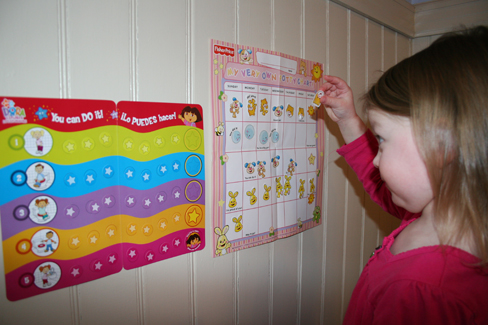
Figure \(\PageIndex{2}\): Sticker charts are a form of positive reinforcement and a tool for behavior modification. Once this little girl earns a certain number of stickers for demonstrating a desired behavior, she will be rewarded with a trip to the ice cream parlor. (credit: Abigail Batchelder)
Time-out is another popular technique used in behavior modification with children. It operates on the principle of negative punishment. When a child demonstrates an undesirable behavior, she is removed from the desirable activity at hand. For example, say that Sophia and her brother Mario are playing with building blocks. Sophia throws some blocks at her brother, so you give her a warning that she will go to time-out if she does it again. A few minutes later, she throws more blocks at Mario. You remove Sophia from the room for a few minutes. When she comes back, she doesn’t throw blocks.
There are several important points that you should know if you plan to implement time-out as a behavior modification technique. First, make sure the child is being removed from a desirable activity and placed in a less desirable location. If the activity is something undesirable for the child, this technique will backfire because it is more enjoyable for the child to be removed from the activity. Second, the length of the time-out is important. The general rule of thumb is one minute for each year of the child’s age. Sophia is five; therefore, she sits in a time-out for five minutes. Setting a timer helps children know how long they have to sit in time-out. Finally, as a caregiver, keep several guidelines in mind over the course of a time-out: remain calm when directing your child to time-out; ignore your child during time-out (because caregiver attention may reinforce misbehavior); and give the child a hug or a kind word when time-out is over.
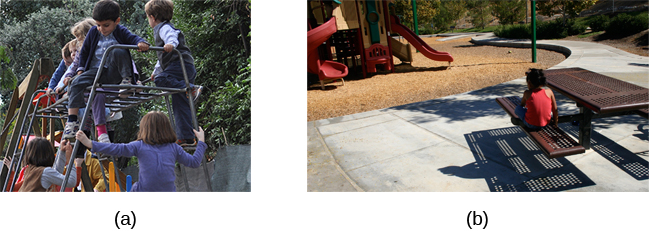
Figure \(\PageIndex{3}\): Time-out is a popular form of negative punishment used by caregivers. When a child misbehaves, he or she is removed from a desirable activity in an effort to decrease the unwanted behavior. For example, (a) a child might be playing on the playground with friends and push another child; (b) the child who misbehaved would then be removed from the activity for a short period of time. (credit a: modification of work by Simone Ramella; credit b: modification of work by “JefferyTurner”/Flickr)
Reinforcement Schedules
Remember, the best way to teach a person or animal a behavior is to use positive reinforcement. For example, Skinner used positive reinforcement to teach rats to press a lever in a Skinner box. At first, the rat might randomly hit the lever while exploring the box, and out would come a pellet of food. After eating the pellet, what do you think the hungry rat did next? It hit the lever again, and received another pellet of food. Each time the rat hit the lever, a pellet of food came out. When an organism receives a reinforcer each time it displays a behavior, it is called continuous reinforcement. This reinforcement schedule is the quickest way to teach someone a behavior, and it is especially effective in training a new behavior. Let’s look back at the dog that was learning to sit earlier in the chapter. Now, each time he sits, you give him a treat. Timing is important here: you will be most successful if you present the reinforcer immediately after he sits, so that he can make an association between the target behavior (sitting) and the consequence (getting a treat).
Once a behavior is trained, researchers and trainers often turn to another type of reinforcement schedule—partial reinforcement. In partial reinforcement, also referred to as intermittent reinforcement, the person or animal does not get reinforced every time they perform the desired behavior. There are several different types of partial reinforcement schedules (See table below). These schedules are described as either fixed or variable, and as either interval or ratio. Fixed refers to the number of responses between reinforcements, or the amount of time between reinforcements, which is set and unchanging. Variable refers to the number of responses or amount of time between reinforcements, which varies or changes. Interval means the schedule is based on the time between reinforcements, and ratio means the schedule is based on the number of responses between reinforcements.
| Reinforcement Schedule | Description | Result | Example |
|---|---|---|---|
| Fixed interval | Reinforcement is delivered at predictable time intervals (e.g., after 5, 10, 15, and 20 minutes). | Moderate response rate with significant pauses after reinforcement | Hospital patient uses patient-controlled, doctor-timed pain relief |
| Variable interval | Reinforcement is delivered at unpredictable time intervals (e.g., after 5, 7, 10, and 20 minutes). | Moderate yet steady response rate | Checking Facebook |
| Fixed ratio | Reinforcement is delivered after a predictable number of responses (e.g., after 2, 4, 6, and 8 responses). | High response rate with pauses after reinforcement | Piecework—factory worker getting paid for every x number of items manufactured |
| Variable ratio | Reinforcement is delivered after an unpredictable number of responses (e.g., after 1, 4, 5, and 9 responses). | High and steady response rate | Gambling |
Now let’s combine these four terms. A fixed interval reinforcement schedule is when behavior is rewarded after a set amount of time. For example, June undergoes major surgery in a hospital. During recovery, she is expected to experience pain and will require prescription medications for pain relief. June is given an IV drip with a patient-controlled painkiller. Her doctor sets a limit: one dose per hour. June pushes a button when pain becomes difficult, and she receives a dose of medication. Since the reward (pain relief) only occurs on a fixed interval, there is no point in exhibiting the behavior when it will not be rewarded.
With a variable interval reinforcement schedule, the person or animal gets the reinforcement based on varying amounts of time, which are unpredictable. Say that Manuel is the manager at a fast-food restaurant. Every once in a while someone from the quality control division comes to Manuel’s restaurant. If the restaurant is clean and the service is fast, everyone on that shift earns a \(\$20\) bonus. Manuel never knows when the quality control person will show up, so he always tries to keep the restaurant clean and ensures that his employees provide prompt and courteous service. His productivity regarding prompt service and keeping a clean restaurant are steady because he wants his crew to earn the bonus.
With a fixed ratio reinforcement schedule, there are a set number of responses that must occur before the behavior is rewarded. Carla sells glasses at an eyeglass store, and she earns a commission every time she sells a pair of glasses. She always tries to sell people more pairs of glasses, including prescription sunglasses or a backup pair, so she can increase her commission. She does not care if the person really needs the prescription sunglasses, Carla just wants her bonus. The quality of what Carla sells does not matter because her commission is not based on quality; it’s only based on the number of pairs sold. This distinction in the quality of performance can help determine which reinforcement method is most appropriate for a particular situation. Fixed ratios are better suited to optimize the quantity of output, whereas a fixed interval, in which the reward is not quantity based, can lead to a higher quality of output.
In a variable ratio reinforcement schedule, the number of responses needed for a reward varies. This is the most powerful partial reinforcement schedule. An example of the variable ratio reinforcement schedule is gambling. Imagine that Sarah—generally a smart, thrifty woman—visits Las Vegas for the first time. She is not a gambler, but out of curiosity she puts a quarter into the slot machine, and then another, and another. Nothing happens. Two dollars in quarters later, her curiosity is fading, and she is just about to quit. But then, the machine lights up, bells go off, and Sarah gets \(50\) quarters back. That’s more like it! Sarah gets back to inserting quarters with renewed interest, and a few minutes later she has used up all her gains and is \(\$10\) in the hole. Now might be a sensible time to quit. And yet, she keeps putting money into the slot machine because she never knows when the next reinforcement is coming. She keeps thinking that with the next quarter she could win \(\$50\), or \(\$100\), or even more. Because the reinforcement schedule in most types of gambling has a variable ratio schedule, people keep trying and hoping that the next time they will win big. This is one of the reasons that gambling is so addictive—and so resistant to extinction.
In operant conditioning, extinction of a reinforced behavior occurs at some point after reinforcement stops, and the speed at which this happens depends on the reinforcement schedule. In a variable ratio schedule, the point of extinction comes very slowly, as described above. But in the other reinforcement schedules, extinction may come quickly. For example, if June presses the button for the pain relief medication before the allotted time her doctor has approved, no medication is administered. She is on a fixed interval reinforcement schedule (dosed hourly), so extinction occurs quickly when reinforcement doesn’t come at the expected time. Among the reinforcement schedules, variable ratio is the most productive and the most resistant to extinction. Fixed interval is the least productive and the easiest to extinguish. See figure below.
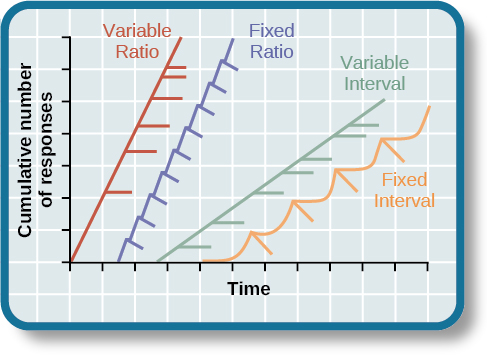
CONNECT THE CONCEPTS: Gambling and the Brain
Skinner (1953) stated, “If the gambling establishment cannot persuade a patron to turn over money with no return, it may achieve the same effect by returning part of the patron's money on a variable-ratio schedule” (p. 397).
Skinner uses gambling as an example of the power and effectiveness of conditioning behavior based on a variable ratio reinforcement schedule. In fact, Skinner was so confident in his knowledge of gambling addiction that he even claimed he could turn a pigeon into a pathological gambler (“Skinner’s Utopia,” 1971). Beyond the power of variable ratio reinforcement, gambling seems to work on the brain in the same way as some addictive drugs. The Illinois Institute for Addiction Recovery (n.d.) reports evidence suggesting that pathological gambling is an addiction similar to a chemical addiction (See figure below). Specifically, gambling may activate the reward centers of the brain, much like cocaine does. Research has shown that some pathological gamblers have lower levels of the neurotransmitter (brain chemical) known as norepinephrine than do normal gamblers (Roy, et al., 1988). According to a study conducted by Alec Roy and colleagues, norepinephrine is secreted when a person feels stress, arousal, or thrill; pathological gamblers use gambling to increase their levels of this neurotransmitter. Another researcher, neuroscientist Hans Breiter, has done extensive research on gambling and its effects on the brain. Breiter (as cited in Franzen, 2001) reports that “Monetary reward in a gambling-like experiment produces brain activation very similar to that observed in a cocaine addict receiving an infusion of cocaine” (para. 1). Deficiencies in serotonin (another neurotransmitter) might also contribute to compulsive behavior, including a gambling addiction.
It may be that pathological gamblers’ brains are different than those of other people, and perhaps this difference may somehow have led to their gambling addiction, as these studies seem to suggest. However, it is very difficult to ascertain the cause because it is impossible to conduct a true experiment (it would be unethical to try to turn randomly assigned participants into problem gamblers). Therefore, it may be that causation actually moves in the opposite direction—perhaps the act of gambling somehow changes neurotransmitter levels in some gamblers’ brains. It also is possible that some overlooked factor, or confounding variable, played a role in both the gambling addiction and the differences in brain chemistry.
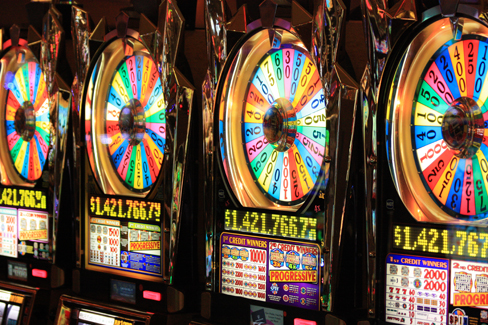
Cognition and Latent Learning
Although strict behaviorists such as Skinner and Watson refused to believe that cognition (such as thoughts and expectations) plays a role in learning, another behaviorist, Edward C. Tolman, had a different opinion. Tolman’s experiments with rats demonstrated that organisms can learn even if they do not receive immediate reinforcement (Tolman & Honzik, 1930; Tolman, Ritchie, & Kalish, 1946). This finding was in conflict with the prevailing idea at the time that reinforcement must be immediate in order for learning to occur, thus suggesting a cognitive aspect to learning.
In the experiments, Tolman placed hungry rats in a maze with no reward for finding their way through it. He also studied a comparison group that was rewarded with food at the end of the maze. As the unreinforced rats explored the maze, they developed a cognitive map: a mental picture of the layout of the maze (Figure \(\PageIndex{6}\)). After \(10\) sessions in the maze without reinforcement, food was placed in a goal box at the end of the maze. As soon as the rats became aware of the food, they were able to find their way through the maze quickly, just as quickly as the comparison group, which had been rewarded with food all along. This is known as latent learning: learning that occurs but is not observable in behavior until there is a reason to demonstrate it.
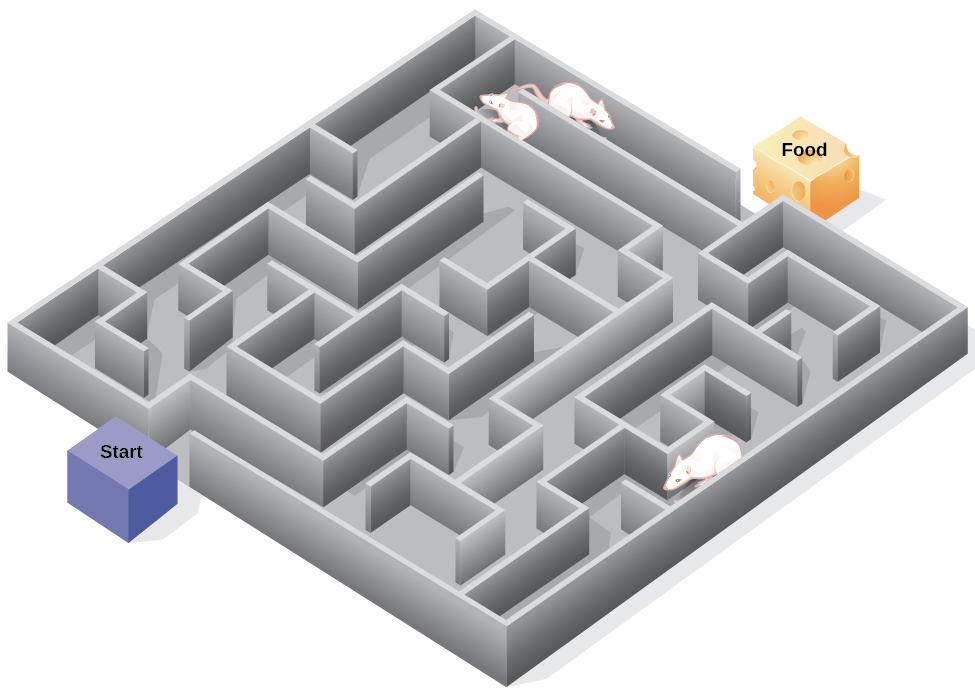
Latent learning also occurs in humans. Children may learn by watching the actions of their parents but only demonstrate it at a later date, when the learned material is needed. For example, suppose that Ravi’s dad drives him to school every day. In this way, Ravi learns the route from his house to his school, but he’s never driven there himself, so he has not had a chance to demonstrate that he’s learned the way. One morning Ravi’s dad has to leave early for a meeting, so he can’t drive Ravi to school. Instead, Ravi follows the same route on his bike that his dad would have taken in the car. This demonstrates latent learning. Ravi had learned the route to school, but had no need to demonstrate this knowledge earlier.
EVERYDAY CONNECTION: This Place Is Like a Maze
Have you ever gotten lost in a building and couldn’t find your way back out? While that can be frustrating, you’re not alone. At one time or another we’ve all gotten lost in places like a museum, hospital, or university library. Whenever we go someplace new, we build a mental representation—or cognitive map—of the location, as Tolman’s rats built a cognitive map of their maze. However, some buildings are confusing because they include many areas that look alike or have short lines of sight. Because of this, it’s often difficult to predict what’s around a corner or decide whether to turn left or right to get out of a building. Psychologist Laura Carlson (2010) suggests that what we place in our cognitive map can impact our success in navigating through the environment. She suggests that paying attention to specific features upon entering a building, such as a picture on the wall, a fountain, a statue, or an escalator, adds information to our cognitive map that can be used later to help find our way out of the building.
Summary
Operant conditioning is based on the work of B. F. Skinner. Operant conditioning is a form of learning in which the motivation for a behavior happens after the behavior is demonstrated. An animal or a human receives a consequence after performing a specific behavior. The consequence is either a reinforcer or a punisher. All reinforcement (positive or negative) increases the likelihood of a behavioral response. All punishment (positive or negative) decreases the likelihood of a behavioral response. Several types of reinforcement schedules are used to reward behavior depending on either a set or variable period of time.
Glossary
- cognitive map
- mental picture of the layout of the environment
- continuous reinforcement
- rewarding a behavior every time it occurs
- fixed interval reinforcement schedule
- behavior is rewarded after a set amount of time
- fixed ratio reinforcement schedule
- set number of responses must occur before a behavior is rewarded
- latent learning
- learning that occurs, but it may not be evident until there is a reason to demonstrate it
- law of effect
- behavior that is followed by consequences satisfying to the organism will be repeated and behaviors that are followed by unpleasant consequences will be discouraged
- negative punishment
- taking away a pleasant stimulus to decrease or stop a behavior
- negative reinforcement
- taking away an undesirable stimulus to increase a behavior
- operant conditioning
- form of learning in which the stimulus/experience happens after the behavior is demonstrated
- partial reinforcement
- rewarding behavior only some of the time
- positive punishment
- adding an undesirable stimulus to stop or decrease a behavior
- positive reinforcement
- adding a desirable stimulus to increase a behavior
- primary reinforcer
- has innate reinforcing qualities (e.g., food, water, shelter, sex)
- punishment
- implementation of a consequence in order to decrease a behavior
- reinforcement
- implementation of a consequence in order to increase a behavior
- secondary reinforcer
- has no inherent value unto itself and only has reinforcing qualities when linked with something else (e.g., money, gold stars, poker chips)
- shaping
- rewarding successive approximations toward a target behavior
- variable interval reinforcement schedule
- behavior is rewarded after unpredictable amounts of time have passed
- variable ratio reinforcement schedule
- number of responses differ before a behavior is rewarded


